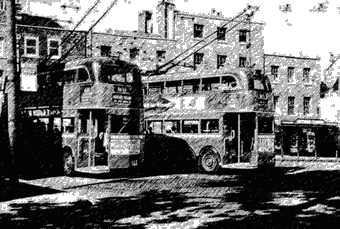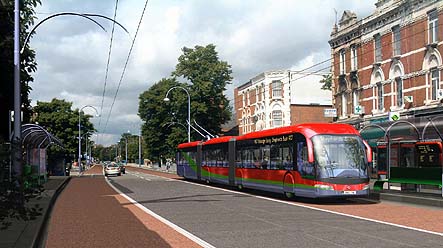The Historical Background
London came relatively late to trolleybuses, when London United
introduced them in the Twickenham and Teddington area in 1931.
They replaced old fashioned trams that had worn their track out.
The experiment was very successful and hailed as such by the
company and passengers alike. The first 60 trolleybuses were
followed two years later by an exceptionally modern vehicle which
set the standard not just for London but the rest of the country
as well. Trolleybuses were providing cheap, quiet and clean
transport for the residents of south west London. The only
problem was radio interference as the trolleybuses passed and
complaints led to fitting of special coils on the roofs of the
vehicles that eliminated the problem.
 The formation of the London Transport Passenger Board in 1933
saw the 61 trolleybuses of London United pass into new ownership.
Their success had a major impact on future planning. London
Transport was faced with a pressing need to modernise the tramway
system, as well as upgrade and extend the Underground. It was
considered at the time to be easier to replace the 2,500 trams
with the newly-developed trolleybus [but after the 1939-45 war,
with diesel-engined buses]. London's last conventional trams
ran in 1952.
The formation of the London Transport Passenger Board in 1933
saw the 61 trolleybuses of London United pass into new ownership.
Their success had a major impact on future planning. London
Transport was faced with a pressing need to modernise the tramway
system, as well as upgrade and extend the Underground. It was
considered at the time to be easier to replace the 2,500 trams
with the newly-developed trolleybus [but after the 1939-45 war,
with diesel-engined buses]. London's last conventional trams
ran in 1952.
![Last Tram Week ticket [1952]](../images/ltw2.gif) Since 1952, there has been a huge increase in the availability
and use of private cars in London, and new roads and traffic
management schemes have not kept pace with the potential demand.
Public opposition has grown on environmental and social grounds
to proposals for major road schemes through already built-up
areas, which would in any case be hugely expensive.
Since 1952, there has been a huge increase in the availability
and use of private cars in London, and new roads and traffic
management schemes have not kept pace with the potential demand.
Public opposition has grown on environmental and social grounds
to proposals for major road schemes through already built-up
areas, which would in any case be hugely expensive.
The Current Position
Today, in conurbations worldwide, buses are not perceived by
passengers to be an attractive, reliable and high quality means
of travel, mainly because of delays caused by traffic congestion
and the relatively poorer ride quality of buses as against rail
vehicles. Underground railways are extremely expensive and can
only be justified where there is a prospect of large numbers of
passengers being carried. Alternative ways of meeting the need
for a public transport system which is more reliable than the
bus, but cheaper and quicker to build than tramway systems, are
now in operation around the world and, of these, modern
trolleybus systems have become the most favoured.
Of approximately 350 trolleybus systems currently operating
around the world many have undertaken extensive new investment
programmes and extensions in the last few years. 40 completely
new systems have been built in the last dozen years and include:
- Quito in Ecquador
- Genova and Bologna - Italy
- Kobenhaven - Denmark
- Nanning - China
- Ghent - Belgium
- Daikanbo-Murdo - Japan
- Chomutov and Ceske Budejovice - Czech Republic
- Liverpool - UK [planned]
- Paris - France [planned]
Over 10 new systems have opened in Russia, 11 in Rumania, and
plans have been formulated for Brighton, London and Watford in
the UK. Major extensions have been built in Zurich and Quito.
Hong Kong is currently examining the introduction of trolleybuses
and 200 are about to be ordered in Vancouver.
 |
Artist's impression of a new breed of Trolleybus
for the Uxbridge Road.
Click on picture for an enlarged version. |
Features of a Modern Trolleybus
What are sometimes known as "Tbuses" use the latest
technology and can
run in single or articulated units in the
middle of streets, in pedestrian precincts or on their own private way.
A single articulated trolleybus can carry up to 200
people - two and a half times the capacity of a typical bus - and
is designed to be accessible to all sections of the community,
including mothers with pram's and small children, shoppers with
trolleys, the elderly and people with disabilities.
The stops are seldom more than 600 metres apart. With segregated roadway and
priority at traffic signals, there are no hold-ups in traffic
jams, and the service is safe and reliable.
Many European cities already run trolleybuses on streets and
through city centres. Trolleybuses do not cause pollution in the
street to damage the urban environment and the vehicles are
extremely quiet with fast, smooth acceleration and quick and safe
braking. They can negotiate tight turns and climb steep
gradients. Trolleybus systems can be designed to complement all
urban surroundings, and this flexibility is increasingly
attractive to town planners, who are turning to trolleybus
technology to ease the problems of urban traffic congestion.
Trolleybus systems are relatively cheap to build - cheaper
than tram systems and with virtually all the advantages. The
current UK average cost is £300k - £400k per kilometre [£500k
- £640k per mile], including overhead, vehicles, etc.; about 5 -
10 per cent of the price of a tramway system. However, they are
more expensive than bus systems and a careful examination of the
business case for a scheme has to be taken before a decision to
proceed can be made.
London Transport and Trolleybuses
London Transport has been studying the development of
trolleybuses for a number of years, and now has a team dedicated
to bringing the advantages of modern electric street transport to
London.
Future Developments in London
In June 1995, London Transport published "New Ideas for
Public Transport in outer London" [now out of print] which
set out the case for improved public transport facilities in over
40 areas, involving intermediate mode schemes which bridge the
gap between heavy rail and conventional bus services. In addition
to light rail, these modes could include electrically-powered and
alternative fuel vehicles; segregated and guided busways; and
people-movers.
A detailed analysis of nine of these schemes has now been
completed and work on developing these ideas is being carried on
by various parts of London Transport.
In central London, London Transport is a partner with local
authorities, private firms and the Government Office for London
in the Cross River Partnership, which is dedicated to improving
facilities on both banks of the river and to providing better
cross-river links. One of the most promising of these
developments is a proposal to develop a trolleybus, a high
quality surface link from Stockwell and Peckham in south London,
via Waterloo, Kingsway and Euston to Camden and Kings Cross in
the north. Active development work on the scheme is being
continued by the partners, led by London Transport. The proposed
layout of the scheme has been developed and consultants are
examining the demand for such a new transport link, its impact
upon general road traffic in central London and its environmental
impact. Further development work and public consultation will
continue over the next year.
Postscript
Dr Sue Atkinson, Director of Public Health for London, has been on London Live Radio to announce a report in which is
stated that London air pollution kills more people than road traffic accidents. In 12 months studied 226 people were
killed in RTAs, but it is estimated by the experts commissioned for the report that 380 deaths were "brought
forward" by air pollution. These were people particularly who suffered respiratory problems made worse by
pollution.
Of ways for individuals to reduce these affects, Dr Atkinson mentioned more walking and cycling [lower exposure to
pollution than in cars]. However, not mentioned were trolleybuses with their zero exhaust emissions which would help
to overall pollution and, unlike a tramway, don't introduce additional hazards for cyclists by slots along roads.
If only there could be some integrated thinking by planners of transport and health.
Revised 27th November 2004
 The formation of the London Transport Passenger Board in 1933
saw the 61 trolleybuses of London United pass into new ownership.
Their success had a major impact on future planning. London
Transport was faced with a pressing need to modernise the tramway
system, as well as upgrade and extend the Underground. It was
considered at the time to be easier to replace the 2,500 trams
with the newly-developed trolleybus [but after the 1939-45 war,
with diesel-engined buses]. London's last conventional trams
ran in 1952.
The formation of the London Transport Passenger Board in 1933
saw the 61 trolleybuses of London United pass into new ownership.
Their success had a major impact on future planning. London
Transport was faced with a pressing need to modernise the tramway
system, as well as upgrade and extend the Underground. It was
considered at the time to be easier to replace the 2,500 trams
with the newly-developed trolleybus [but after the 1939-45 war,
with diesel-engined buses]. London's last conventional trams
ran in 1952.![Last Tram Week ticket [1952]](../images/ltw2.gif) Since 1952, there has been a huge increase in the availability
and use of private cars in London, and new roads and traffic
management schemes have not kept pace with the potential demand.
Public opposition has grown on environmental and social grounds
to proposals for major road schemes through already built-up
areas, which would in any case be hugely expensive.
Since 1952, there has been a huge increase in the availability
and use of private cars in London, and new roads and traffic
management schemes have not kept pace with the potential demand.
Public opposition has grown on environmental and social grounds
to proposals for major road schemes through already built-up
areas, which would in any case be hugely expensive.